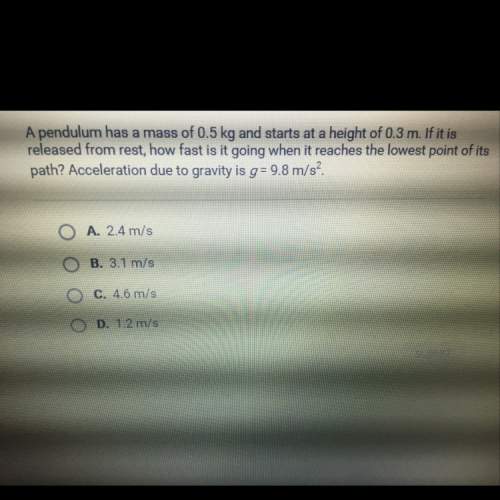
Physics, 28.11.2020 06:20 amandasantiago2001
Dolphins rely on echolocation to be able to survive in the ocean. In a 20 °C ocean, a dolphin produces an ultrasonic sound with a frequency of 125 kHz. What is the wavelength of this sound, in meters?While remaining stationary, the dolphin emits a sound pulse and receives an echo after 0.220 s. How far away, in meters, is the reflecting object from the dolphin?

Answers: 1


Other questions on the subject: Physics

Physics, 21.06.2019 19:30, desiwill01
Contrast the force of gravity between these pairs of objects a 1 kg mass and a 2 kg mass that are 1 m apart and two 2 kg masses that are 1 m apart
Answers: 2

Physics, 21.06.2019 21:30, jwoody5495
Although light from the sun appears white, it is actually made up of a lot of different colors. this portion of the electromagnetic spectrum, we call white light is referred to as within the electromagnetic spectrum.
Answers: 1

Physics, 22.06.2019 01:00, muhammadcorley123456
4. who was the first one to measure the speed of light and conclude that it is finite? 5. who was the first philosopher who thought the speed of light is finite? 13. what is the speed of light numerically? 14. give an example of something moving faster than light 15. give an example for some particles or waves that
Answers: 1

Physics, 22.06.2019 01:00, anna4060
First, launch the video below. you will be asked to use your knowledge of physics to predict the outcome of an experiment. then, close the video window and answer the question at right. you can watch the video again at any point. part a as in the video, we apply a charge +q to the half-shell that carries the electroscope. this time, we also apply a charge –q to the other half-shell. when we bring the two halves together, we observe that the electroscope discharges, just as in the video. what does the electroscope needle do when you separate the two half-shells again? view available hint(s) as in the video, we apply a charge + to the half-shell that carries the electroscope. this time, we also apply a charge – to the other half-shell. when we bring the two halves together, we observe that the electroscope discharges, just as in the video. what does the electroscope needle do when you separate the two half-shells again? it deflects more than it did at the end of the video. it deflects the same amount as at end of the video. it does not deflect at all. it deflects less than it did at the end of the video. submit
Answers: 2
You know the right answer?
Dolphins rely on echolocation to be able to survive in the ocean. In a 20 °C ocean, a dolphin produc...
Questions in other subjects:

Mathematics, 23.04.2020 02:13


Mathematics, 23.04.2020 02:13


Mathematics, 23.04.2020 02:14

Physics, 23.04.2020 02:14


History, 23.04.2020 02:14

History, 23.04.2020 02:14




